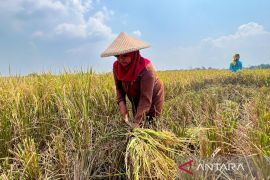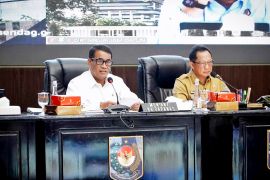The food crisis alarm in Indonesia has rung since early 2023 following a disruption in the global supply chain due to geopolitical conflicts in several countries. The food crisis has also gotten worse due to the occurrence of the El Nino phenomenon that triggers a prolonged drought.
As one of the countries crossed by the equator, Indonesia has experienced prolonged drought since the middle of the year due to El Nino that has reduced food production in several areas.
The impact of El Nino has resulted in crop failures in central to southern Sumatra, Java Island, Bali to Nusa Tenggara, southern Kalimantan, most of Sulawesi, parts of North Maluku, parts of Maluku, and southern Papua.
Statistics Indonesia (BPS) also forecasts that rice production for the rest of this year will decline, as is apparent in the four main rice-producing regions, namely South Sulawesi, where it is estimated to decline by 21.7 percent; a decrease of 17.4 percent in Central Java; 11-percent decline in West Java; and down by 4.4 percent in Lampung.
Meanwhile, Indonesian rice consumption increases, especially towards the end of the year. In the January-September 2023 period, the projected figure for national rice consumption reached 22.89 million tons as compared to the same period last year of 22.62 million tons.
The acting agriculture minister, who is concurrently head of the National Food Agency (Bapanas), Arief Prasetyo Adi, confirmed that the impact of El Nino reduced Indonesia's rice production by 1.2 million tons, from this year's production target of 30 million tons.
Food supplies are also threatened, as Indonesia’s trading partner countries are facing the same problem. Those countries implemented food export restriction policies to maintain their domestic food supply.
Until early October 2023, some 22 countries are limiting their rice exports. The two countries as Indonesia’s rice suppliers -- India and Vietnam -- are also included on the list. This is resulting in a challenge to fulfill domestic rice demand in Indonesia. The country must secure import quota agreements with several other countries despite the realization not being needed at this time.
Price stabilization
El Nino, which causes extreme hot weather and drought, disrupts national crop production. Water supplies to several food production centers have decreased due to the lack of rain. The hot weather also caused forest and land fires that hampered food production.
As a result of this production disruption, the rice prices soared. Considering that the end of the year is momentum for high public consumption, decreasing food production combined with increasing public demand could trigger inflation above the government’s rate.
Acting Head of BPS, Amalia Adininggar Widyasanti, stated that until the end of September 2023, the rice price trend was still soaring, with no signs of reduction. The average rice price reaches Rp13,477 per kilogram.
Moreover, the number of districts and cities experiencing an increase in rice prices is also growing. In the first week of September 2023, some 230 regions were experiencing an increase in rice prices. The number shifted to 284 regions in the third week of September 2023.
Coordinating Minister for Economic Affairs Airlangga Hartarto highlighted that the impact of an increase in rice prices on inflation was 0.05 percent. Meanwhile, data from the Trade Ministry until early October recorded that rice prices in Jabodetabek (Jakarta-Bogor-Depok-Tangerang-Bekasi) and West Java have started to fall.
President Joko Widodo (Jokowi) then exerted greater efforts to prevent the food crisis from occurring through steps, including by maintaining rice availability and price stability. The president also ordered state-run logistics company, Bulog, to increase rice supply for Food Price Stability and Supply (SPHP) to 100 thousand tons per month, from the earlier 50 thousand tons per month.
The government will also continue the rice social assistance program of at least 200 thousand tons per month. Thus, there will be at least an additional supply of 300 thousand tons of rice per month in the market.
Rice stocks in Bulog warehouses will also be released and not piled up to control prices. Commercial rice and not the government rice reserves (CBP) will be distributed to accelerate the distribution of price-controlling rice as well as helping rice mills that are currently unable to absorb rice grain, as the prices are too high.
These efforts are expected to control rice prices in the next one to two months while maintaining inflation to the target of three percent, give or take one percent.
Moreover, the government continues to monitor corn prices in order to maintain the inflation rate as well.
Additional 1.5 million tons of rice
Rice harvest for the second planting season is expected to occur in early November of 2023. However, the government is keen to secure its rice reserves to avoid the worst possibility, such as a decreased production result due to El Nino that is forecast to last until early 2024.
The government is striving to secure an additional import quota of 1.5 million tons of rice from Thailand, Vietnam, and Cambodia.
According to Acting Minister Adi, some 600 thousand tons from the additional 1.5 million tons will arrive in Indonesia on December 31, 2023, at the latest. Currently, the government's rice reserves in Bulog amounted to 1.7 million tons.
Apart from imports, the government also aimed to optimize crop production in the second planting season this year. Hence, the government must disburse incentives for Indonesian farmers in the form of production-supporting infrastructure, such as water supply assistance, and the availability of seeds and fertilizers.
Minister of Public Works and Public Housing (PUPR) Basuki Hadimoeljono also guaranteed sufficient amount of water supply to support production in November 2023.
Indonesia still has around 2.9 billion cubic meters of water for meeting 81 percent of the irrigation needs. The water supply source is supplied from 3,464 reservoirs around areas with irrigation. Other sources are supplied from 332 lakes and 8,213 wells for agricultural irrigation needs.
Apart from rice, the government will also increase import quotas for feed corn and sugar to control prices in the market that continue to spike.
For feed corn, the government will increase the import quota to 250 thousand tons. Meanwhile for sugar, the government will immediately realize the remaining 70 percent of this year's import quota by making policy adjustments as an incentive to help the domestic sugar prices become more competitive as compared to global prices.
In securing stocks and maintaining price stability, imports had become one of the considerations although not on the priority list.
Fulfilling food supplies and stabilizing prices should be the government's priority among other challenges, as food is a crucial element in people’s lives.
During the final period of his leadership, President Jokowi's focus on maintaining food supplies and stabilizing prices needs to be strengthened. Efforts must be made to avoid food problems from disrupting social stability, especially approaching the 2024 general election.
Related news: Agriculture Ministry works with Bulog to absorb farmers' production
Related news: Government to establish food estate in Merauke as KEK
Related news: Home minister promotes food diversification to cut reliance on rice
Translator: Indra Arief P, Resinta Sulistiyandari
Editor: Azis Kurmala
Copyright © ANTARA 2023












